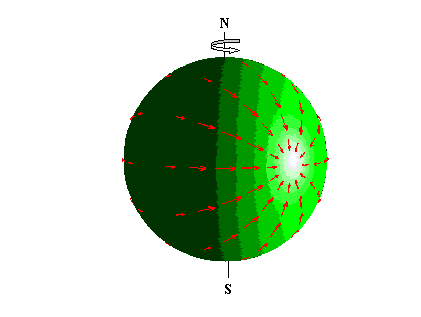Dynamic Tides
In contrast to “static” theory, the dynamic theory of tides recognizes that water covers only three-quarters of our planet and is confined to seas and ocean basins that are fixed on a rotating earth. Since solar as well as lunar tractive force “nets” (red arrows on green sphere) remain aligned with their respective celestial parents, an ocean or sea on this rotating earth experiences forces of constantly changing magnitude and direction (the earth’s crust is also affected by these forces, creating small but detectable “earth tides”).
 As the diagram at left illustrates, the horizontal force
fields that act on the water masses rotating with the earth are not at all
random like winds blowing across the surface of a lake. Instead, they repeat
definite patterns with a kind of “push me, pull me” rhythm. Ocean waters
respond with a wave-like motion characterized by definite periods – tidal
periods – identical to the ones derived from equilibrium theory. But how can
water confined to a basin engage in wave motion at all like the “tidal bulges”
that supposedly sweep around the globe as depicted in equilibrium theory
(previous module)?
As the diagram at left illustrates, the horizontal force
fields that act on the water masses rotating with the earth are not at all
random like winds blowing across the surface of a lake. Instead, they repeat
definite patterns with a kind of “push me, pull me” rhythm. Ocean waters
respond with a wave-like motion characterized by definite periods – tidal
periods – identical to the ones derived from equilibrium theory. But how can
water confined to a basin engage in wave motion at all like the “tidal bulges”
that supposedly sweep around the globe as depicted in equilibrium theory
(previous module)?
The answer is – it can’t. Not without encountering a solid boundary that results in reflection of the waveform that then travels back the way it came. When a reflected wave meets a new wave still advancing toward the boundary, their combination (depending on wave period, size and shape of the basin) can lead to a standing wave – a waveform that doesn’t go anywhere but merely oscillates up and down like a seesaw. You can create a standing wave of this type in your coffee cup with a gentle back and forth motion. But that’s not all. A further consequence of being on a rotating earth is that water masses in motion experience an apparent force per unit mass called Coriolis acceleration that turns their flows to the right in the northern hemisphere and to the left in the southern hemisphere. Lateral boundaries counter this flow as well, but instead of producing another standing wave, a rotary wave or Kelvin wave results. Roughly speaking, you have a Kelvin wave – or a trapped wave as it is sometimes called - in your coffee cup when you swirl it to the left or right.Although they generally appear nothing like the rotary wave in your coffee cup, tidal motions in basins large and small do take the form of large, somewhat irregular rotary waves (recall that most ocean basins open into other basins – like a cup with a broken lip – and have irregular bottom topography and coastline shape). These rotary waves comprise what is known as an amphidromic system, a system that characteristically features a central point (the amphidromic point) where there is no vertical tide, combined with a tide wave of a certain amplitude sweeping around the perimeter of the system once every twelve (lunar) hours. In a cylindrical basin, the simplest representation of the water surface is a tilted plane rotating counter-clockwise about a vertical axis:
The amphidromic point with zero tide in the above “basin” obviously lies at the intersection of the central vertical axis with the tilted plane. What about the tide running along the perimeter of the basin? Reverting to the coffee cup analogy, what would a time history of the fluid level look like to a fly stuck on the wall? There’s a less disgusting way to find out. Take a cardboard tube and cut it at an angle so that the cut section is a tilted plane like the one shown above. Then cut the tube parallel to its axis along the side and unroll it on a flat surface. The edge that was cut first will form a sine wave. As it turns out, tides are composed of nothing else but a collection of sine waves of different period, amplitude, and phase. The sum of all the sine waves that originate from the tractive forces of the moon and sun are collectively known as the astronomical tide.

